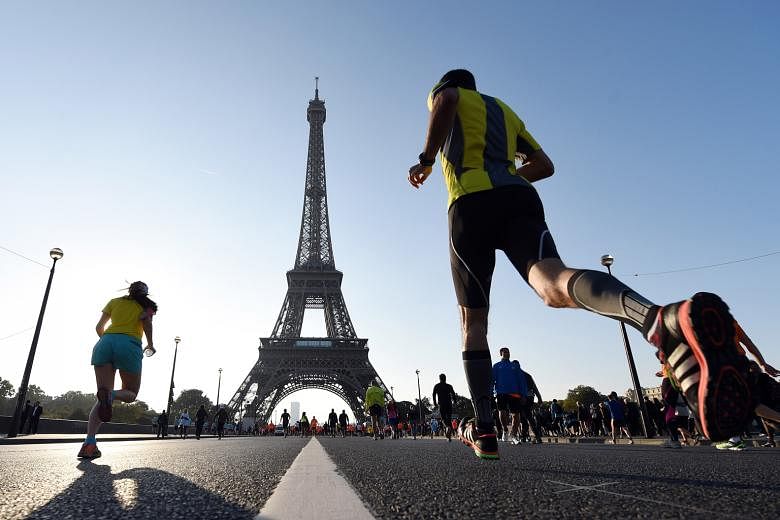About 7km into the race, my right buttock feels like it is going to disengage and fall right off my body.
I am running okay, shuffling up a steep incline along Avenue de Chateau in Meudon in the south- western suburbs of Paris. Pain attacks my gluteal muscles as I look in mild panic at the runners around me - most are going strong, some not even breaking pace. I look ahead of me in despair and all I see is unending miles of hill. I look behind me and all I see is a sea of determined runners, tens of thousands of them. Far, far in the distance is Paris, too far to crawl back to by now.
At this point, my initial enthu- siasm about seeing France on Asics-clad foot has waned a little. The idea seemed so enticing initially: run a mere 16km from the Eiffel Tower in the heart of Paris into the beautiful city of Versailles, right up the tree-lined boulevard to (almost) the gilded gates of the Palace of Versailles. How romantic! How unusual! How... agonising!
The Paris-Versailles La Grande Classique is a unique race in that it goes mostly uphill, peaking 160m above sea level. You finish the race about 100m higher than the start point - Versailles sits on a plateau about 140m above sea level, compared to Paris at 33m.
The race is organised by the Paris-Versailles Association, which exists for the chief goal of organising the race each year.
-
How to sign up for the race
-
The Paris-Versailles La Grande Classique race takes place this year on Sept 25.
Registration opens tomorrow. Slots, which are limited to 25,000, get snapped up fairly fast.
Go to www.parisversailles.com for registration and details. Note that you will need an official letter from your physician that you are fit to run this race.
This letter or certificate must be submitted with your registration or no race bib will be issued.
Registration costs €28 (about S$44) before June 1 and €34 (about S$53) after that.
The race pack includes an official running shirt, race bib with timing chip and various snacks and goodies. The registration fee does not include entry into the Versailles palace grounds.
-
Getting there
-
To Paris:
Many major airlines offer a Singapore-Paris route, including Singapore Airlines, Qatar Airways, Emirates Airways and EVA Air, which has Hello Kitty-themed planes.
To get to Versailles by train:
Take the RER "C" train from Champ des Mars train station near the Eiffel Tower towards Versailles-Chateau Rive Gauche. The train journey takes about 45 minutes.
To get to Versailles by bus:
Take the Coach Versailles Express from the Eiffel Tower. The coach operates from Tuesday to Sunday with two departures a day at 8am (back at 12.30) and 2pm (back at 6pm). Alternatively, you can take Bus 171 from Pont des Sevres bus terminal. The journey to Versailles takes about 30 minutes.
To enter the Versailles estate:
It is worth setting aside at least a full day to enjoy the Chateau de Versailles and the Gardens of Versailles. Some visitors stay overnight in Versailles so they can make the most of their trip over two days.
A one-day passport which gives access to the full estate and all the tours costs €18 (or €25 if you want to enjoy the Musical Fountain Show).
A two-day passport costs €25. It is also a good idea to plan and book your ticket ahead and skip that snaking queue for tickets.
• Go to www.chateauversailles.fr for booking and timing details.
2016 will mark the 39th edition of the run that began in 1976. The run was not held for two years.
Mr Hubert Gueriau, media director for Paris-Versailles, says it all began when "some friends based in Versailles decided to run from Paris to Versailles".
The route was mapped and the first run saw 3,000 participants. That number grew to 26,000 sign-ups last year.
The race route takes you through seven communes or cities: Paris, Issy-les-Moulineaux, Meudon, Chaville, Velizy, Viroflay and Versailles. It is a delightfully scenic route, provided that one has trained sufficiently to enjoy the run and the view. Alternatively, one can sign up for a 5km walk that covers part of the final stretch of the race route, starting in Chaville and ending at the finish line in Versailles.
The historical significance of Paris and Versailles is what drew me to this race in the first place. Versailles was the de facto capital of the kingdom of France for about a hundred years - the Grand Century - when King Louis XIV moved his court and government from Paris to the Chateau de Versailles.
His reign as the absolute monarch of France brought peace to the country and he constructed one of the greatest palaces in the world, with gardens that take the breath away. Little wonder this tiny city has inspired movies and books galore.
The very idea of running down the boulevard leading up to this palace, such a tremendous piece of historical architecture, was thrilling enough to drive me to sign up. Over the past three years, my husband and I have planned overseas holidays around interesting races. This one counts as a unique one that we have had the good fortune to experience.
It is a chilly 10 deg C when we head out from our Airbnb apartment in Paris' third arrondissement and catch the Metro and the RER "C" Line to Champ des Mars, the train station near the Eiffel Tower.
Arriving at 8am, two hours ahead of the flag-off time, we first head to the race village at the Emile Antoine Stadium, about 300m away from the start point.
Runners gamely join in the warm-up exercises led by fitness instructors, jogging and stretching against a backdrop of blue skies and the iconic wrought-iron structure of the Eiffel Tower.
International races generally attract a large mixed bag of global running enthusiasts, but the beauty of the Paris-Versailles is that it is not (yet) as popular as the Disneyland races or the World Marathon Majors.
Today, we are privileged to be two of a small handful of Asians in a sea of mostly European runners and a number of elite runners from Nigeria, Ethiopia and Kenya.
The energy at the start point is palpable before the race: More than 20,000 runners form a rippling sea that is to be flagged off in waves by French celebrity sprinter Jimmy Vicaut, starting at 10am. It is thrilling to start the race this way, ready and waiting on Quai Branly, with the Eiffel Tower looming over us.
The first third of the route is smooth and scenic as runners progress down closed-off roads from Paris central through Issy-les-Moulineaux in the Val-de-Seine, the business district in the 15th arrondissement.
We are flanked by sparkling waters and bridges on the right and, on the left, chic skyscrapers and office buildings that are home to French television companies such as Canal+, France24 and TF1. The flat ground of the first 6km takes us to the start of Meudon and it is here that we turn left up a slope that marks the start of two straight kilometres uphill - 2,100m, to be exact.
This stretch is the highlight of the Paris-Versailles race, christened "Cotes des Gardes".
Historically, this was the route the royal armies took when Louis XIV commanded the move of his court and government from Paris to Versailles. This hill is also famous among running enthusiasts as an achievement to be unlocked.
(Later, too late, I read blogs by Americans who flew into Paris days or a week beforehand to run up the Cotes des Gardes a number of times before the race day.) The highest point of the hill is 175m - as high up as Robinson 77 on Shenton Way.
I admire and simultaneously envy the French runners; many of them must have trained on this very road in the weeks leading up to today, judging from the easy manner in which they conquer the incline.
What spur me to hobble onwards are the wonderful crowds that have appeared along the roads to cheer us on. Toddlers and young children, some sitting atop their parents' shoulders, shout out words of encouragement. I grin and wave, and they wave back.
Thankfully, the road levels off shortly past the 8th km as we reach the verdant forest that marks the Route Royal. While the ground is much flatter, the paved streets now turn into a somewhat sludgy trail road, which demands more intense legwork. The dense forest also brings the temperature down, making the air a little harder to breathe in. But there is something magical about running through such misty hinterland. One almost expects to see a horse-drawn carriage clip-clopping by.
We exit the forest and enter through Chaville where the road dips steeply. Going uphill is bad, but going downhill here is almost worse. The slope is so steep it is impossible to walk down - one has to run.
The reward for braving this insanity is running into Velizy and down the picturesque Route de la Fontaine d'Ursine, past what must be the most glorious lake in all of France, through a township speckled with white houses and charming churches, greeted by an enthusiastic school band playing Queen's Another One Bites The Dust. It almost takes the agony out of yet another hill we have to climb.
The anticipation of Versailles grows as we traverse Velizy's Allee Noire and stretches of vineyards in Viroflay, feeling the warmth of the late morning. As we enter the entrance to Versailles, the cheerful playing of another band greets us.
The sun seems brighter and the skies bluer in Versailles, and all the agony of the last 14km dull as the finish line - and beyond it, the Palace of Versailles - beckons. The majestic Avenue de Paris is an inviting boulevard, lined with lush emerald trees, that inspires runners to make a final dash through the 2km towards the finish line.
Reaching the finish line of the ParisVersailles La Grande Classique feels sweeter than almost any other race that I have taken part in, with the exception of the Disneyland inaugural Avengers Half-Marathon, but that is another travelogue for another time.
The sheer difficulty of the Paris- Versailles route makes this conquest more precious - definitely a deep notch in my running belt.
The cut-off time for the race is 3 hours and 30 minutes.
Winner Ethiopian David Fikasu Admassu crosses the finish line in a mere 47 minutes 42 seconds. Lesser mortals take a while longer, and then there is me - I clear the line well past the second hour.
A few runners are spotted joining the snaking Sunday queue of thousands to enter the Palace of Versailles. My husband and I content ourselves with sauntering up to Place d'Armes, downing bottles of isotonic drinks as we seek shelter under the bronze statue of Louis XIV that guards the palace gates.
Refreshed, we enter through the gates that lead to the entrances to the palace, the Trianon palaces and Marie Antoinette's hamlet, the French Gardens and the park. Just standing there gazing on the palace is enough to inspire awe, but it is when one takes in the grandeur of the entrance to Versailles that the magnitude of completing the run hits you.
With buttocks aching but intact, we board the train to Paris, happy that we have experienced France in a way few tourists have.
• Theresa Tan is a freelance writer and editor. She is also the author of A Clean Breast.




